|
Click Here to return to Boston Illustrated Content Page Click Here to return to Previous Chapter |
 (HOME) |
|
Click Here to return to Boston Illustrated Content Page Click Here to return to Previous Chapter |
 (HOME) |
|
II. THE NORTH END, Final Section.
In the section of the city which we have included in the North End district four of the eight railroads terminating in Boston have their stations — three of them within a stone’s throw of each other, on Causeway Street. Our view represents the stations of the Eastern and Fitchburg Railroads, with a section of the newer Lowell station in the foreground. The Eastern station is an unpretentious building of brick, erected in 1863, after the destruction by fire of the former station. The Eastern Railroad was leased in 1883 for 54 years to the Boston wd Maine, and is now the Eastern Division of that Railroad. In connection with the Maine Central, its ears run through to Bangor, Me. there making close connection with the St. John, New Brunswick, railroad system. In addition to the extensive through travel thus secured, this Eastern Division of the Boston and Maine Railroad performs an exceedingly large amount of local business for the cities and towns along the coast to Portsmouth, while its North Conway division enjoys a large share of the White Mountain travel during the summer and autumn seasons. In 1847 the total number of passengers carried on this line was but 651,408. Over 6,000,000 have been carried in a single year, since 1870. 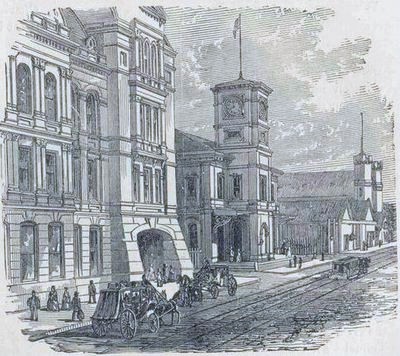 Eastern and Fitchburg Railroad Stations. The station of the Fitchburg Railroad is represented at the extreme right hand of our sketch. It was built in 1847, the terminus of the road having previously been in Charlestown. In a great hail in the upper part of this structure, two grand concerts were given by Jenny Lind in October, 1850, to audiences numbering on each occasion more than four thousand people. The Fitchburg Railroad passes through several important suburban towns, and transacts an extensive local and through business. It is directly connected with the Hoosac Tunnel and the great trunk lines west, maintaining the through line from Boston to North Adams, under leases of the roads beyond Fitchburg. It has excellent terminal facilities at tide-water. The Lowell Railroad possesses one of the finest passenger-stations in the country, as well as one of the largest. It is seven hundred feet long, and has a front of two hundred and five feet on Causeway Street; the material is face brick with trimmings of Nova Scotia freestone. The arch of the train-house has a clear span of one hundred and twenty feet without any central support. The head-house contains the offices of the company and very large and convenient waiting and other rooms for the accommodation of passengers. The Boston and Lowell is leased by the Boston and Maine. It is practically united with the great New Hampshire lines; and over its tracks the cars of the Central Vermont and the Boston, Concord, and Montreal enter the city. 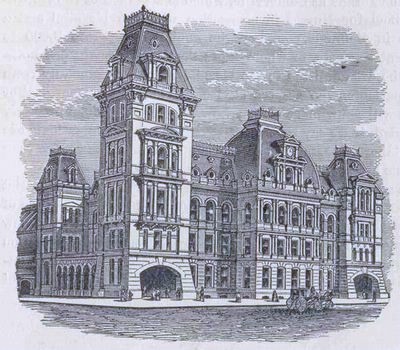 Lowell Railroad Station. The Boston and Maine Railroad, alone of all lines entering the city on the north side, enjoys the privilege of penetrating within the outer street. Its station is in Haymarket Square, and the open space in front of it gives prominence to the structure. The Maine road conducts a large local business, while operating under leases the Eastern and Lowell systems. It is a favorite line to Portland and beyond, as it passes along the Maine coast near the sea-side hotels of Saco. 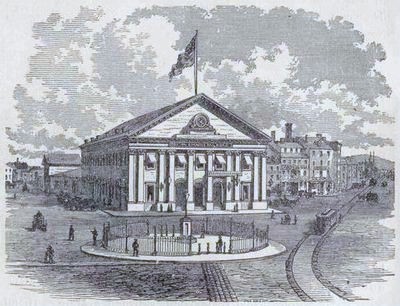 Haymarket Square. Two leading hotels of Boston, the American and the Revere House, are in this part of the city. The American House, on Hanover Street, is one of the largest hotels in New England. Its external appearance was greatly improved by the widening of Hanover Street. It covers the sites of four former hotels,—Earle’s, the Merchants’, the Hanover, and the old American Houses. Upon a portion of the ground it now occupies, the dwelling of General Warren formerly stood. It was rebuilt in 1851, and numerous additions have been made since. The interior has also been completely remodelled within a few years. A large passenger elevator was added to the house when elevators were first introduced. The grand dining-room is capable of seating at one time more than three hundred people; at either end mammoth mirrors reach from the floor to the ceiling. The American has been under one management for forty years. It is conducted on the American plan.  American House. The Revere House is not strictly within the limits of the district we have drawn, but it is separated from that district only by the width of a single street. lit is a building of fine appearance. It was erected by the Massachusetts Charitable Mechanic Association, and was for a long time under the management of the veteran, Paran Stevens. It was, of course, named in memory of Paul Revere, the patriotic mechanic of Boston before and during the Revolution, and the first president of the Charitable Mechanic Association. Colonel Revere was a companion and fellow-worker with Samuel Adams, James Otis, Joseph Warren, and others of the leaders of opinion in the days of the Stamp and Tea Acts. The versatile colonel appears in the first Directory of Boston, for 1789, as a goldsmith doing business at No. 50 Cornhill, —now Washington Street. The hotel which bears his name has entertained more distinguished men than any other in Boston. The Prince of Wales occupied apartments in the Revere on his visit to the city in 1860; General Grant was several times a guest of the house; and in the winter of 1871 it was the headquarters of the Grand Duke Alexis of Russia. The Revere is situated in Bowdoin Square. In 1885 the interior was rearranged and the cafe enlarged and decorated. The house is conducted on the European plan. 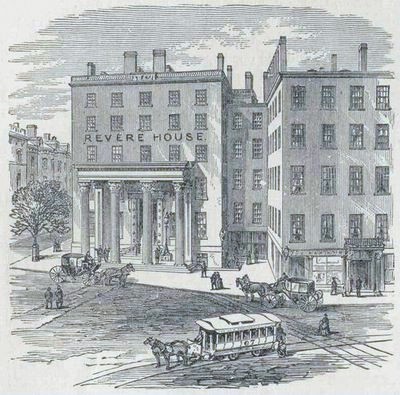 Revere House. In Brattle Street is another long established and comfortable hotel, — the Quincy House. This also was in 1885 extensively enlarged and modernized. Near the Quincy, facing Brattle Square for many years, the famous Brattle Square Church stood. This was long known as the Manifesto Church, the original members having put forth in 1699, just before their church was dedicated, a document declaring their aims and purposes. While themselves adopting the belief which was then universal among the Congregational churches of the time, they conceded the right of difference of belief among the members. They also abolished the distinction between church and congregation. Expecting a difficulty in getting ordained in Boston, their first minister was ordained in London. The modest church edifice built in 1699 was taken down in 1772, and the second building erected on the same spot, was dedicated on the 25th of July, 1773. During the Revolution the pastor, who was a patriot, was obliged to leave Boston, services were suspended, and the British soldiery used the building as a barrack. A cannon-ball from a battery in Cambridge or from a ship of war in Charles River struck the church; and this memento of the glorious contest was afterwards built into the external wall of the building, above the porch. Among the long line of eminent clergymen who have been pastors of this church, may be mentioned the late Edward Everett, and John G. Palfrey. The old church was sold in 1871, and the last service was held in it July 30 of that year, a memorial sermon being preached on that occasion by the pastor, Rev. Dr. S. K. Lothrop. The ancient pulpit, the old bell, the organ, the historic cannon-ball, and some other mementoes, were reserved at the sale. The society built a new church in the Back Bay district which is noticed elsewhere. 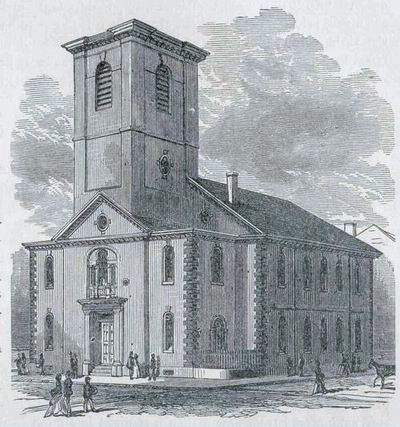 Brattle Square Church (demolished in 1872.) Two of the most noticeable, though not the most extensive, of the street improvements of recent years, have taken place within the district we have defined as the North End. The first was the removal of an uninteresting old structure, a landmark and meeting-place in the Boston of a dozen years ago, known as Scollay’s Building, and the creation thereby of what is now called Scollay Square. This square is the most irregular of triangles. Court Street empties into it in the most curious way possible, and for a time the left side of the street is lost. It is Tremont Row where it ought to be Court Street. Then the right side is similarly lost, Court Street and Sudbury Street being separated by as invisible a line as is the equator. But finally both parts of the street resume their course after a space where there is no Court Street, until the wonderful avenue loses itself at last in Bowdoin Square. Scollay Square is now a sort of street-railroad centre. Within it is the bronze statue of Governor Winthrop, a duplicate of that standing in the Capitol at Washington. It represents Winthrop as he landed in the New World. The right hand holds the colony charter, and the left the volume of the Scriptures. The statue is by Richard S. Greenough. It was put in place in September, 1880. The other improvement is the extension of Washington Street to Haymarket Square and the Boston and Maine Railroad Station. The new street was opened in 1874, having cost over $1,500,000, and makes a marked improvement in that section of the city. Near its union with the older part of Washington Street it broadens into an irregular triangle, extending towards Faneuil Hall, and bordered on two sides by imposing business blocks of light-colored stone. This triangle is now called Adams Square. In about the centre of it is the Samuel Adams statue from which the open space takes its name. This is by Miss Anne Whitney, and was put in place in June, 1880. It represents the patriot as he is supposed to have appeared after demanding from Hutchinson and his council the removal of the British troops from Boston, after the “Boston Massacre,” and awaiting the reply to his demand. Washington Street now makes a straight line from State Street to the Boston and Maine Station, whence it is prolonged by Charlestown Street to the Charlestown Bridge. Near the meeting-point of Washington and Charleston Streets is the Roman Catholic Church of St. Mary (on Endicott Street), one of the largest religious edifices in Boston, with a beautiful altar of many-colored marbles. |